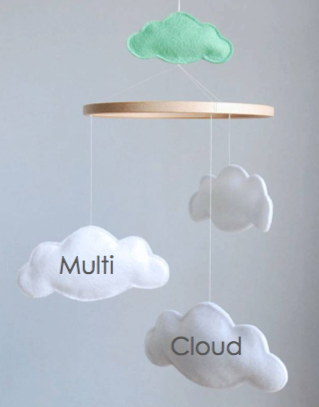What drives the creation of countless apps, tools and platforms in the IT market today?
The ever-growing web as well as the `consumerization of IT` provide end users with an abundance of options and full discretion. We now understand the vital need to internalize the concept of spreading knowledge and information across a variety of applications and platforms as a means to thrive. Fortunately, we now have the opportunity to utilize multiple clouds.
Why?
There are various incentives when considering multi-cloud deployment, including regulations, high-availability, and global presence, to name a few. However, when looking at the main factors, two key words come to mind: Evolution and Freedom.
Evolution.
IT has made incredible advancements over the past decade, and from the looks of it, there are no signs of slowing down. The infinite public IaaS resources have translated into an endless supply of new applications. While the environment is made up of many intricacies, countless accommodating innovations are progressively being adopted on a regular basis. That is the beauty of our dynamic IT environment, there is always something new on the table.
The consumerist habit of buying an application for a dollar, then tossing it out after a day without blinking an eye, has made its way to the business world. Now, enterprises and end users, alike, are expecting to enjoy the bottom-up adoption of cloud computing to materialize on their work desks. With risk-free trials lowering cloud lock-in opportunities, the world of IT is becoming more and more heterogeneous. For critics of change, this concept may seem hard to swallow, nonetheless, it is out of our hands and acceptance is the healthiest choice.
To learn more about the factors and players shaping today’s heterogeneous IT environment, join Ofir Nachmani’s session at the the next IGT Meetup Conference that will take place at the Google Campus in Tel Aviv. Free Registration here
Freedom
The researcher and cloud pundit Dave McCrory, who coined the term “Data Gravity”, intended to help IT consumers assess the potential for vendor lock-in, insisting that data stay as “free” as possible. In the olden days, database storage options were limited to on-premise or collocation centers, decreasing the range of flexibility if budget or data distinctions played a significant role. The evolution of IT has granted users the choice and opportunity to store and scale their relational databases using platforms such as Amazon RDS, Google Cloud RDS and innovative startups like ScaleBase. Now, users have the freedom and responsibility to store and read data using different platforms and switch according to the needs of their application.
Developers and DevOps today recognize their responsibility and importance of building a platform that is separate from the underlying infrastructure. Application containers, such as Docker and Cloudbees, enable that independence. This delineation is crucial when discussing cloud adoption and is discussed in depth in RavelloSystems’ post approach to the issue.
There will always be gaps when coordinating between cloud capabilities. In fact, in terms of network speed, Google has demonstrated that its platform can complement AWS cloud (based on an actual integration case study). The benefits of utilizing multiple platforms heavily outweigh the impediments. As mentioned above, the continuous cultivation and upgrade of cloud solutions presents end users with the best quality and cutting edge offerings. The option to take advantage of every vendor’s prime offer places end users in an ideal situation. Therefore, if one vendor has a more attractive offer than what you currently use, it is your sure that you are able to switch easily.
Challenges (?)
Complexity is definitely a challenge. Generally speaking, utilizing multiple clouds is perceived to create a much more complex environment than a single platform. However, the level of complexity is not contingent upon the number of platforms or clouds in a system. If cloud management is in place, including policies, automation and transparency, moving to a multi-cloud platform configuration should generate lower marginal costs. While it may seem easier said than done, I conducted research of my own, learning that Emind, have managed to move applications between clouds in a matter of weeks. On the topic of complexity, transparency plays a significant role. With endless processes, policies, failures and successes, transparency draws conclusions, which lead to increased understanding, education and improvement, making it one of the most important elements in cloud management.
Don’t be fooled, the cloud vendors as well as the blogger who typed these words want to justifiably lock you in. Nonetheless, it is extremely important to evaluate all of the risks involved and maintain low optional transition costs. Do not fear change. It is fun and advantageous to have more options and utilize multiple solutions. There will never be a one-stop-shop for the cloud. Internalizing that with the cloud, IT is an extreme heterogeneous environment promotes greater flexibility and innovation.
To learn more about the factors and players shaping today’s heterogeneous IT environment, join Ofir Nachmani’s session at the the next IGT Meetup Conference that will take place at the Google Campus in Tel Aviv. Free Registration here
RavelloSystems, Scalebase and Emind>






